Prescribed Burning
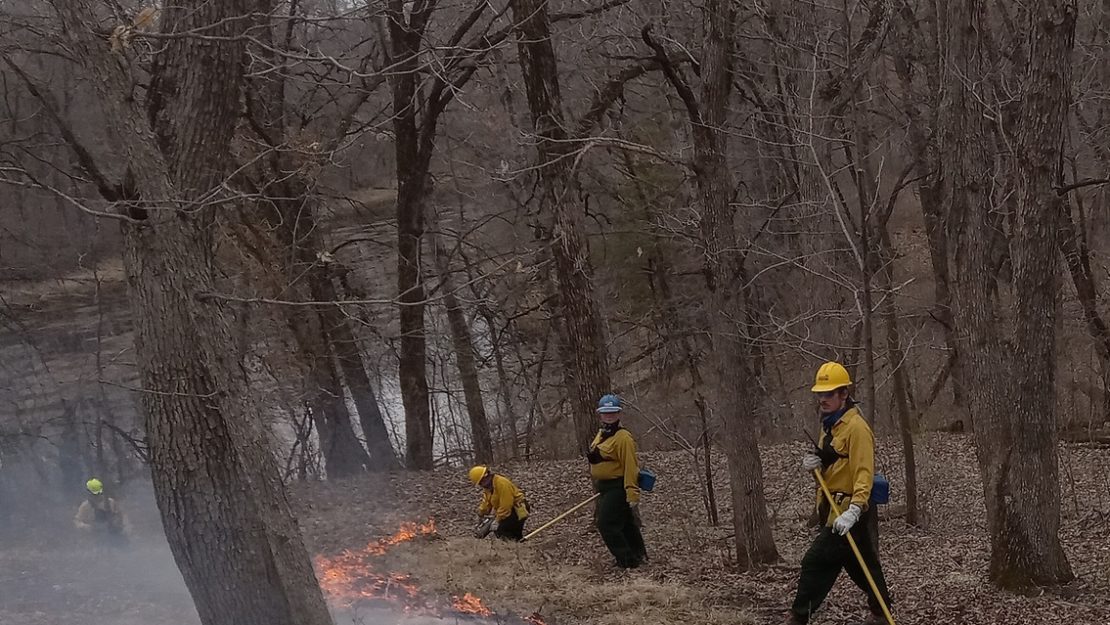
By Karolyn Preiss, Three Rivers 3 Field Crew Member / AmeriCorps Member
The Three Rivers Crews have had an adventurous week!
They had two prescribed burns in as many days.
Prescribed burns generally occur in early or late spring or in the fall as the fuel is more easily flammable before or after it has been at peak green. The prescribed areas are also frequented less often at these times. Due to less canopy overlap and rain-soaked grounds, the fires are also easier to control.

Day 1:

We had our first prescribed burn of the season–the first ever prescribed burn for a number of the crew members!
The site was a long, sprawling field of grass with a new fence installation to protect future seedlings from being ravaged by encroaching deer. The site had been treated the year before with an herbicide to prepare for burning, leaving matted brown grass in place of the spring green grass that was coming up on the adjoining plot of land. The hope is to restore the land to forest. It was donated to the park system by private citizens and is at present primarily hilly grassland surrounded by trees and bog.
The first step was to ensure that all members knew the circumstances of the burn: the full layout of the land to be burned, the weather forecasted plus wind direction and relative humidity, the plan of action being undertaken, escape routes, risk areas to be mindful of and how to react if things were to go wrong, etc.
Signs were placed to inform the general public of the day’s events and personal protective equipment was donned. Two-way radios were tested and utilized as the official coordination began.
It was essential to ensure that the fire would not escape the confines of the area prescribed for burning. In this circumstance, a wet-line methodology was adopted. That means that a line of ground was saturated with water, thus protecting it from starting on fire. (This strategy is also suggested for private residences if a wildfire is threatening your home–pull out the sprinklers and saturate the grass as a first line of defense.)
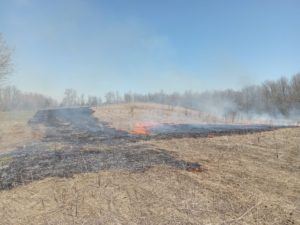
Then, drip torches–fuel canisters with wands of fire at the end–dripped fuel and/or fire along the dripping path, controlled always by the holders of said drip torches.
Other firefighters were on standby with fire tools such as McLeods, Flappers, Shovels, and tanks of water, ready to provide supports if any embers were to cross the wet-line into the no-burn zone.
We started by lighting a backfire as a buffer, meaning that a strip of land at the back of the territory was burned, thus becoming “black” and being no longer burnable as the fuels there were already consumed by fire. This would be a Safe Zone as the fire would have nothing to burn in this area and would be directed to areas with more fuel instead.
The wind was blowing toward it, so the small flames would have to fight to leave the area outlined by the drip-torch–where there was no wet-line laid–making it the most logical place along the perimeter to begin.
After the backfire was lit and naturally extinguished, the drip torchers slowly worked in small sections along the perimeter, keeping pace on either side of the prescribed area, parallel with the wind.
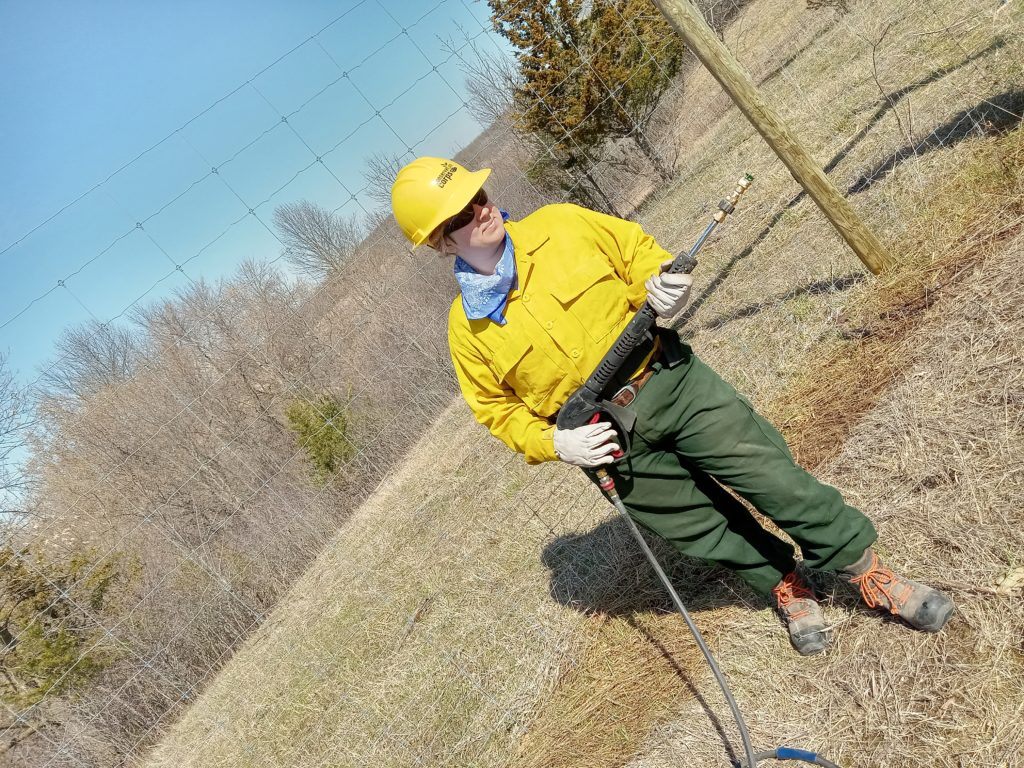
Another rectangle would be dripped and burned, one by one until the area was all char.
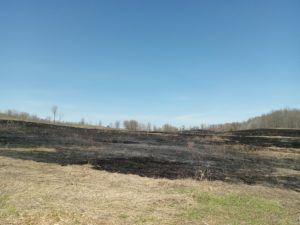
Then, the land was monitored and checked over for “smokes” or areas where embers and/or flame were hidden. These hotspots were extinguished then monitored some more.
Afterward, the area was cleared as safe and/or extinguished, and it was acceptable to leave the premises.
The team met up for an after action review and discussed what happened during the day, what was meant to happen, why things happened the way that they did, and how to move forward for future prescribed burns.
It was a job well-done.
The fire was hot. There were a few spot-fires that jumped the line, but water-trucks assisted in extinguishing the areas. All members of the team got to rotate through the different roles, thus learning multiple dimensions of fire-fighting.
Overall, it was a great first prescribed burn!

Day 2:

The day was warmer, but it felt like rain.
The area prescribed for burning was smaller than Day 1’s, but it was on a slope with many more trees and larger fuels to be burned. Rolling, flaming logs were a potential hazard!
As the area was wooded, water trucks did not have easy access to the land, thus limiting their usefulness on-site. Hoses connected to the trucks could be dragged through on foot, and back-pack soakers were on stand-by; however, lines needed to be established in another way to protect the surrounding environment.
As this was the case, dry lines were established by leaf-blowing and raking away leaf detritus and dead grass, the primary fuels to be burned. Ladder fuels, leaning fuels that overlapped or led up to the canopy where fire was not desired, were eliminated with chainsaws.
Rakes were also used to pull debris from the bases of the trees as a protection tool, then the fires were started.
A backfire was established as a buffer. There was a natural break along the edge since there was a trail. This served as another safety feature.
Then, the burners worked downhill along the perimeter, as was the case on day 1.
A few strips were burned along the top of the prescribed area, then a fire was lit at the base of the hill–the base of the prescribed area– the thought-process being that the wind and uphill nature of the fuels would easily carry the fire through the designated area.
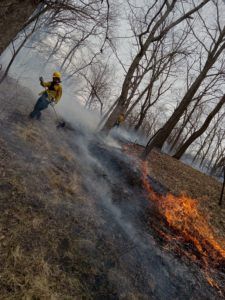
Rain and healthy, moist grass made some of the flames’ progress a little more hit-or-miss than on Day 1, and the day ended with the “Black” being a bit patchy.
Mop-up–or the procedures for putting out smokes and cleaning up the site–was a longer, more involved process since some large logs did catch on fire. Back-pack soakers and Fire Tools were needed to mitigate these risks.
The day ended and everyone gladly celebrated with a lunch well-earned.
Overall, both prescribed burns were highly educational, and I think that everyone enjoyed themselves immensely.
Working with good people and on projects worthy of time and effort makes for time well-spent.

